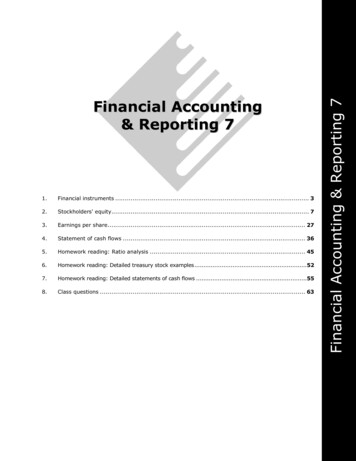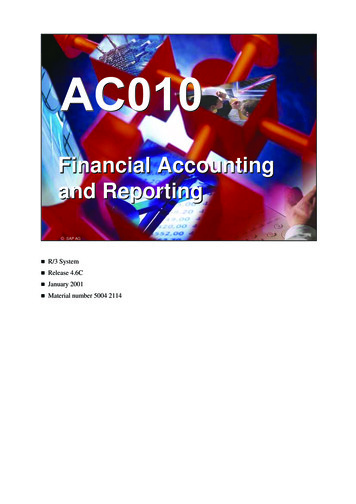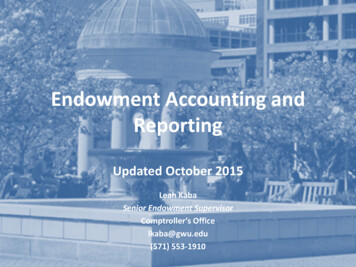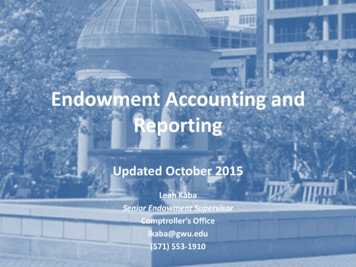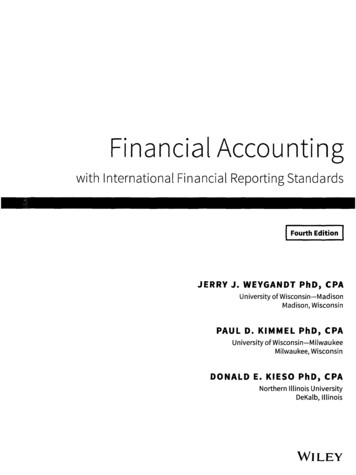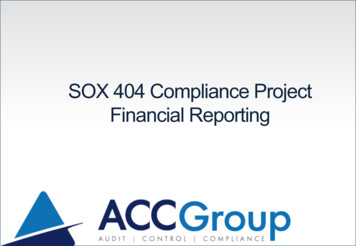
Transcription
1.Sources of GAAP and basic framework and concepts . 32.Reporting net income . 143.Income statement:Income from continuing operations . 17Discontinued operations . 19Extraordinary items . 22Accounting changes and prior period adjustments . 244.Comprehensive income . 315.Balance sheet and disclosures overview . 366.Interim financial reporting . 387.Segment reporting. 398.Development-stage enterprises . 439.Fair value measurements. 4410.Homework reading: Discontinued operations examples . 5011.Homework reading: Sources of GAAP and basic framework and concepts . 5212.Homework reading: Segment reporting. 6313.Homework reading: Enhanced outline for interim financial reporting . 6514.Class questions . 69Financial Accounting & Reporting 1Financial Accounting& Reporting 1
F1-2
Becker CPA ReviewFinancial Accounting & Reporting 1SOURCES OF GAAP AND BASIC FRAMEWORK AND CONCEPTSI.INTRODUCTIONGenerally accepted accounting principles (GAAP) are those accounting principles that havesubstantial authoritative support. Substantial authoritative support is a question of fact and a matterof judgment. The power to establish GAAP actually rests with the Securities and ExchangeCommission (SEC); however, except for rare instances, it has essentially allowed the accountingprofession itself to establish GAAP and self-regulate. Three bodies of the accounting professionhave determined GAAP since 1939.A.COMMITTEE ON ACCOUNTING PROCEDUREThe Committee on Accounting Procedure (CAP) was a part-time committee of the AmericanInstitute of Certified Public Accountants (AICPA) that promulgated Accounting ResearchBulletins (ARB), which determined GAAP from 1939 until 1959.B.ACCOUNTING PRINCIPLES BOARDThe Accounting Principles Board (APB) was another part-time committee of the AICPA. Itissued Accounting Principles Board Opinions (APBO) and APB Interpretations, whichdetermined GAAP from 1959 until 1973.C.FINANCIAL ACCOUNTING STANDARDS BOARDIn 1973, an independent full-time organization called the Financial Accounting StandardsBoard (FASB) was established, and it has determined GAAP since then.1.Statements of Financial Accounting Standards (SFAS)These statements establish GAAP and define the specific methods and procedures forvarious accounting issues. Each statement is issued after extensive research,discussion memoranda, exposure drafts, and public comments.2.FASB InterpretationsFASB Interpretations clarify GAAP by addressing issues that may be conflicting orambiguous and may establish GAAP.3.Technical BulletinsTechnical bulletins may expand upon or further clarify GAAP because of problems thatmay exist in accounting or reporting under the standard or interpretation. 2009 DeVry/Becker Educational Development Corp. All rights reserved.F1-3
Financial Accounting & Reporting 14.Becker CPA ReviewStatements of Financial Accounting Concepts (SFAC)Statements of Financial Accounting Concepts (SFAC) are intended to establish theobjectives and concepts for use by the FASB in developing accounting and reportingstandards. They provide a common foundation and basic reasoning on which toconsider the merits of the alternatives and a coherent system of interrelated objectivesand fundamentals; however, they do not establish GAAP.5.Emerging Issues Task Force Statements (EITF)EITF statements address emergent issues and may show how to account for specificor unusual applications of GAAP. They are less authoritative than Category Apronouncements (see Hierarchy of Sources of GAAP).6.FASB Implementation GuidesThe FASB may also issue implementation guides (in a question/answer format) oncertain accounting issues that the public may have questions on. These are even lessauthoritative than EITF Statements.II.HIERARCHY OF SOURCES OF GAAPIn 2007, the Hierarchy of Generally Accepted Accounting Principles replaced Statement on AuditingStandards (SAS) No. 69 as the source of the hierarchy of sources of GAAP. This statementindicates the six most authoritative GAAP pronouncements (provided they are not superseded byanother pronouncement). It is permissible, but extremely rare, to deviate from one of the sixpronouncements if compliance would cause the financial statements to be misleading.F1-4A.Accounting Research Bulletins (ARBs)B.Accounting Principles Board Opinions (APBOs)C.FASB Statements of Financial Accounting StandardsD.FASB Staff PositionsE.FASB InterpretationsF.FASB Statement Implementation Issues 2009 DeVry/Becker Educational Development Corp. All rights reserved.
Becker CPA ReviewFinancial Accounting & Reporting 1TheHouse of GAAPOther Accounting LiteratureFASB Concepts Statements; APB Statements; AICPA Issues Papers;International Accounting Standards Committee Statements; GASBStatements, Interpretations, and Technical Bulletins; pronouncements ofother professional associations or regulatory agencies; AICPA TechnicalPractice Aids; and accounting textbooks, handbooks, and articlesCategory D consists of items thatindicate wide-spread industry practiceor explanations and specialapplications of GAAP.AICPAAccounting Interpretationsand Implementation GuidesCategory C consists of pronouncementsthat have not been offered for publiccomment and that have been issued byexperts in accounting.AICPAAccounting StandardsExecutive CommitteePractice Bulletins*Category B consists of pronouncementsthat have been offered for publiccomment and have been issued byexperts in accounting.AICPAIndustry Auditand AccountingGuides*Category A consists of pronouncementsissued by authoritative entities. Theymay include the SEC if the company ispublicly-traded (Staff AccountingBulletins or SABs rules and interpretationreleases of the SEC).The foundation of GAAP consists ofthe Financial Accounting Conceptsissued by the FASB.AccountingAICPAPrinciples BoardAccountingOpinions –ResearchAPBOBulletins(From AICPA)1938-591959-72 Questions andAnswerspublished byFASB staffPrevalentindustrypracticesFASBEmerging Issues TaskForceConsensus PositionsAICPAStatementsof ements1973 EITFD taffInterpretations ImplementationPositionsIssues1973 1973 2004 The House of GAAP rests on a foundation of basic concepts and broadprinciples that underlie financial reporting: going concern assumption,substance over form, neutrality, accrual basis, conservatism, andmateriality. The foundation also includes objectives of financial reporting,qualitative characteristics of accounting information, elements of financialstatements, and recognition and measurement in financial statements.*AICPA Industry Audit and Accounting Guides and AICPA Statements of Position are included in Category B only if the FASBhas cleared the pronouncements. AICPA Practice Bulletins are included in Category C only if cleared by the FASB. Ifnot cleared by the FASB, AICPA Industry Audit and Accounting Guides and AICPA Statements of Position are included inCategory D.NOTE: If the accounting treatment of a transaction or event is not specified by a pronouncement in "Category A" (firstfloor), the auditor should consider whether one or more sources in Category (B), (C), or (D) is relevant to the circumstances.The auditor should be prepared to justify a conclusion that another treatment is generally accepted.If there is a conflict between accounting principles relevant to the circumstances from one or more sources in Category(B), (C), or (D), the auditor should follow the treatment specified by the source in the more authoritative category – for example,follow Category (B) treatment over Category (C) – or be prepared to justify a conclusion that a treatment specified by a sourcein the less authoritative category better presents the substance of the transaction in the circumstances. 2009 DeVry/Becker Educational Development Corp. All rights reserved.F1-5
Financial Accounting & Reporting 1III.Becker CPA ReviewCONCEPTUAL FRAMEWORK UNDERLYING FINANCIAL ACCOUNTINGAs discussed earlier, the FASB has created a conceptual framework (set forth in pronouncementscalled Statements of Financial Accounting Concepts, or SFAC) that serves as a basis for all FASBpronouncements. Six SFAC provide a basis for financial accounting concepts for businessenterprises (SFAC No. 4 relates to non-business enterprises).A.SFAC NO. 1 "OBJECTIVES OF FINANCIAL REPORTING BY BUSINESS ENTERPRISES"SFAC No. 1 defines the potential users of financial reporting as those who base theirdecisions on their relationships to and knowledge about the business enterprise. This groupincludes external users (e.g., investors, creditors, and customers) and those who advisethese users.The objectives essentially identify the purposes and goals of financial accounting and focuson providing information that is useful in making business and economic decisions to personswith reasonable knowledge of business and the economy.The objectives provide:B.1.Information useful in investment and credit decisions.2.Information useful in assessing future cash flow prospects.3.Information useful in assessing an enterprise's resources, the debt and equity claims tothose resources, and the changes in them.SFAC NO 2 "QUALITATIVE CHARACTERISTICS OF ACCOUNTING INFORMATION"The qualitative characteristics of accounting information provide the criteria used to selectand evaluate accounting information so that it will meet the objectives set forth in SFAC No.1. This statement identifies the hierarchy of qualitative characteristics that are to beconsidered when accounting alternatives are available in order to choose the alternative thatproduces the most useful information.Financial information must be:F1-6(i)Understandable to decision makers,(ii)Relevant (timely information with predictive or feedback value),(iii)Reliable (verifiable, faithfully representable, and , and(vii)Less costly than the benefit provided. 2009 DeVry/Becker Educational Development Corp. All rights reserved.
Becker CPA Review1.Financial Accounting & Reporting 1Illustration of Hierarchy of Accounting QualitiesA Hierarchy of Accounting QualitiesFAC No. 2Decision Makersand Their CharacteristicsUsers of AccountingInformation(for example, understanding or prior knowledge)Pervasive ConstraintBBenefits sion UsefulnessPrimary DecisionSpecific QualitiesRelevanceT imelinessIngredients ofPrimary QualitiesP redictiveValueSecondary andInteractive QualitiesV erifiabilityF eedbackValueR epresentationalF aithfulnessN eutralityConsistencyComparabilityThreshold wo pervasive constraints (one on the top and one on the bottom of the illustration)must be considered.a.Costs and BenefitsThe benefits of accounting information must be greater than the costs ofobtaining and presenting the information.b.MaterialityThe information must be material with respect to the financial statements (so thatthe lack of the information could make a difference in decisions made by theusers). 2009 DeVry/Becker Educational Development Corp. All rights reserved.F1-7
Financial Accounting & Reporting 13.Becker CPA ReviewUnderstandabilityThe accounting information presented should be understandable to a wide variety ofusers who possess a reasonable amount of knowledge about the economy and arewilling to exert a reasonable amount of effort to study the information presented.Understandability serves as a link between the characteristics of users and thedecision-specific qualities of information.4.Primary Qualities of Decision UsefulnessDecision usefulness is the primary quality of accounting information. It can be brokendown into two specific categories:a.RelevanceIn order for information to be useful, it has to be relevant (i.e., make a difference)to the decision-making process. The quality of relevance has three subcategories:(1)Predictive ValueWhen information has predictive value, it has the ability to assist users inevaluating past, present, or future events.(2)Feedback ValueFeedback value enables decision-makers to confirm prior expectations orto adjust or correct the assessment made.(3)TimelinessTimeliness is having the information available while it is able to influencedecisions.b.ReliabilityIn order for information to be reliable, the users must be able to reasonablydepend on it to be free from error and bias and to be faithfully representative ofwhat it claims to represent. The quality of reliability has three sub-categories:(1)NeutralityNeutrality means that the information is free from bias and free fromoutside influences.(2)Representational FaithfulnessRepres
and evaluate accounting information so that it will meet the objectives set forth in SFAC No. 1. This statement identifies the hierarchy of qualitative characteristics that are to be considered when accounting alternatives are available in order to choose the alternative that produces the most useful information. Financial information must be:


